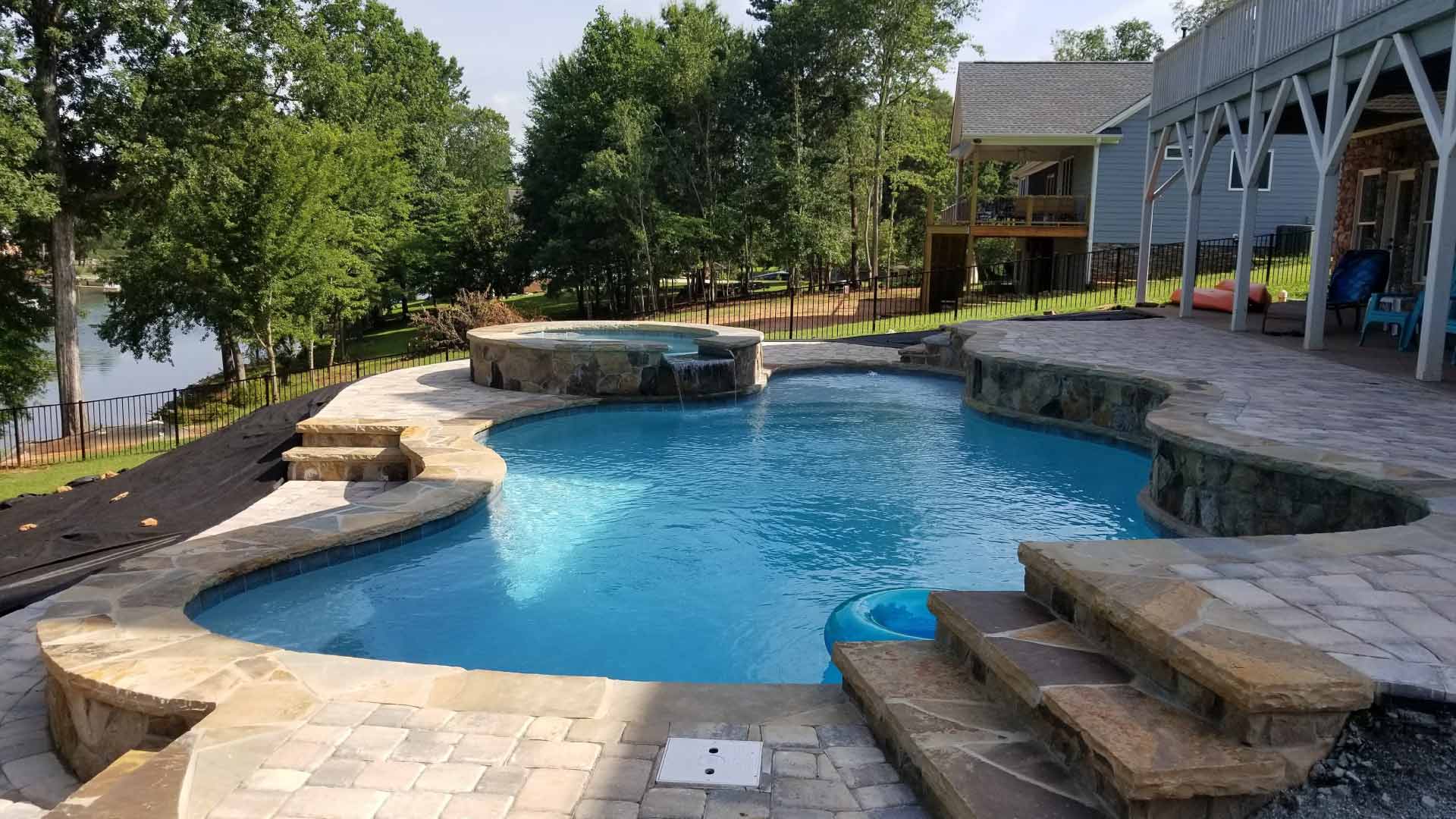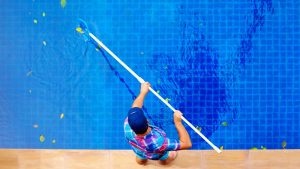In this guide, you will find the main features of concrete pools and the construction process. There are things you should keep in mind when you decide to build a pool in your backyard.
Concrete pools are one of the most desired pools by customers. Concrete allows for more customized spaces because it can be molded right into the landscape and bonds naturally to other materials for a wider range of aesthetics.
Because concrete gives us so many possible results, it is important that you know the processes of this type of construction and the questions that arise within it.
What is the construction process of a concrete swimming pool?
You should know that for building a concrete swimming pool, it is necessary to have suitable and stable ground. In the instance of challenging uneven terrain, it is likely that the process will be longer than that of flat and even ground. Through excavation and grading work along with frame design we can terraform most any typical lot into a suitable pool project. Some of the most beautiful pools are built into less than even ground when given enough space to create tiered portions of even land.
A concrete swimming pool has 16 construction phases, but there are variations. The estimated time for construction is 8 to 10 weeks to meet this goal depending on the client’s requirements for pool design and rely heavily upon weather conditions.
Here we will tell you about the construction process:
Design
Before starting any construction, it is necessary to be clear about the design, the type of pool you want, and the use you give it. Usually, a 3D design is made to pre-visualize the design, and once approved, construction can begin.
Excavation
The land where the pool will sit will be excavated, depending on the shape and dimensions. The placement, elevation, and access route have to be approved by the client before starting any activity. It is worth knowing that heavy machinery is necessary for this part of the process.

Steel Framing
Once the above process is complete, steel reinforcing bars are bent and bonded to form a cage in the shape of the pool. This will form the top perimeter, walls, floors, spa, skimmers, and benches. After this, the crew will place the skimmers, drains, and returns. If the construction requires a spa, the jets, airlines, and drains will also be installed.

Plumbing
In this phase, the entire plumbing system consisting of the suction pipes that will bring the water from the pool and the return pipes that will return the water to the pool will be installed and inspected.
Gunite
At this stage, gunite is used to shape the shell of the pool. Gunite is a type of concrete applied with a high pressure pneumatic hose. A dry sand and cement mixture is blown through the hose using compressed air then water is injected to hydrate the concrete before it is sprayed by the nozzleman into the previously formed steel structure. The consistency of the mixture along with proper technique in application is what gives the pool its structure and stability. The rough finish of gunite is left textured for better application of the finish plaster.

Tile and pool liner
The next step is to tile the perimeter of the pool. Tile work is an artisan trade and the tiles are installed by hand by craftsmen. The type of tiles and other materials to be used depends on the finishes that have been decided upon in the design phase of the project. Tiles are used frequently to give pools more character and add further protection from the elements, especially at the waterline. There are virtually endless varieties of shapes, colors, and textures in the world of tile, but many of the products that are used in pool projects are time tested and practical for most pool designs.
Pump and filtration equipment
A low consumption pump typically around 2HP is installed to move water to and from the pool. There is also an easy clean filter to collect the debris that will be a normal part of use. This equipment helps to maintain the water quality and keep the pool moving and fresh. These systems are backed by a three year warranty.
Plastering
Once the concrete is dry and the pool has been cleaned, the inside of the surface can be plastered. This composite mix is ideal for new or existing surfaces. Different plaster finishes and aggregates are available. For instance, a factory-mixed Diamond Brite finish can provide the homeowner with an attractive pool in contrast to traditional white plaster coating and, as a benefit, is very durable.
Filling
When the pool is ready with all the accessories and connections, it is necessary to clean all surfaces of the project including dirt and any residues from the construction. Once cleaned you can finally fill your pool with water. All the equipment can be started up, followed by the addition of chemicals into the water.
Once the construction is finished, the construction design should be reviewed. The client should check that everything is in agreement with his requests as well as final inspections that are required by the county. As soon as everything has been checked and approved the pool can be used.
The whole construction process must be precise and cautious. However, as soon as everything is finished, there may be some further questions about the maintenance and durability of this type of swimming pool.
Let’s solve some frequently asked questions that arise to customers.
How long do concrete pools last?
This type of pool can last up to 30 years. The duration depends on the construction process and the proper maintenance by the owner.
Are concrete pools hard to maintain?
All pools need careful maintenance, so the person who takes care of them must have an almost daily cleaning routine. In addition, it helps the swimming pool to be in use without any unnecessary risk. When kept in good condition they have maximum durability.
Pros and cons of a concrete pool
Concrete pools are the most innovative and creative ones. This material offers an infinite number of possibilities for design thanks to its quality.
A major advantage is the different types of finishes that can be used. These are essential parts of the design and will make your pool 100% customizable.
Size and shape. Concrete adapts and allows the creation of customized spaces. Which can be adjusted depending on the use they are going to have. That is a significant advantage over other materials used for swimming pool construction that are premade in a factory.
It is important to note that well maintained water quality in this type of pool is an essential factor for maintenance and avoiding stains on the surface over the years of use.
Durable and adaptable at the same time regarding the structure, and also easily integrated with other materials for decorations purposes.
The accessories and finishes that can be added to this type of pool are varied, this is what attracts the attention of customers.
How much does a concrete swimming pool cost?
The price of a concrete pool can go from fifty thousand dollars and up. It all depends on the accessories and materials used. All the details that you want to invest in the pool can change the final price.
The variables and possibilities that concrete pools present are a feature that can be a decisive factor when you think about building a pool in your yard. For this reason, being able to inform yourself before undertaking any process helps to have a more realistic view of what can result. This guide about concrete swimming pools can be helpful. It is necessary to understand and at the same time have an idea of the time that can be spent in the development of the different processes that are carried in this type of construction project.



